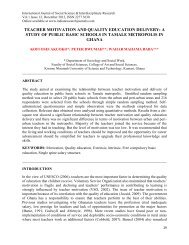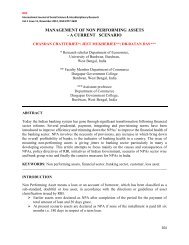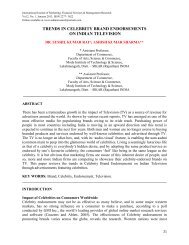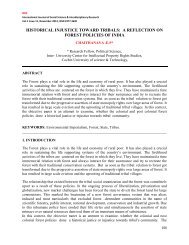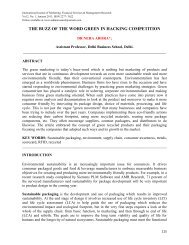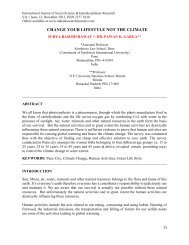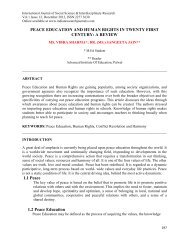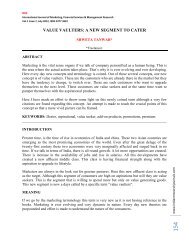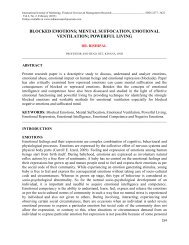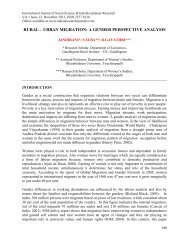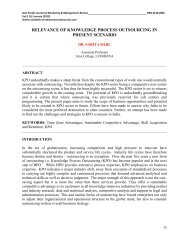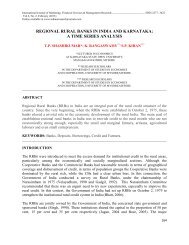dial v for violence: reading karoly kisfaludi's the invisible wound as a ...
dial v for violence: reading karoly kisfaludi's the invisible wound as a ...
dial v for violence: reading karoly kisfaludi's the invisible wound as a ...
Create successful ePaper yourself
Turn your PDF publications into a flip-book with our unique Google optimized e-Paper software.
IRJC<br />
International Journal of Social Science & Interdisciplinary Research<br />
Vol.1 Issue 11, November 2012, ISSN 2277 3630<br />
“Not <strong>the</strong> le<strong>as</strong>t,” he said with a smile. “It is <strong>as</strong> if <strong>the</strong> pain had been cut off and <strong>the</strong> slight<br />
irritation caused by <strong>the</strong> cutting seems like a cool breeze after a hot spell. Just let <strong>the</strong> blood run. It<br />
soo<strong>the</strong>s me”” (6)<br />
Here <strong>the</strong> conversation between <strong>the</strong> doctor and <strong>the</strong> patient exposes certain <strong>as</strong>pects of <strong>the</strong> cathartic<br />
effect that <strong>the</strong> patient experiences. Here tears are replaced by blood. It is apt to mention <strong>the</strong><br />
hydraulic model of emotions and venting <strong>the</strong>ory in this c<strong>as</strong>e <strong>as</strong> blood is used <strong>as</strong> a hydraulic <strong>for</strong>ce<br />
that when given vent to brings peace, calm, rele<strong>as</strong>es tension and heat of body and mind.<br />
Generally, tears carry away <strong>the</strong> negativity of feelings in a cathartic moment and bring in insight.<br />
The hydraulic model of emotions uses <strong>the</strong> analogy of <strong>the</strong> fluid flowing through a system. The<br />
American Psychological Association opines that emotional distress, if not expressed, gets stored<br />
and can create pressure in <strong>the</strong> system, <strong>the</strong>re<strong>for</strong>e 'venting' emotions should decre<strong>as</strong>e tension and<br />
consequentially <strong>the</strong> negative psychological experience and symptoms. The greater <strong>the</strong> expression<br />
of negative emotions, <strong>the</strong> greater <strong>the</strong> relief should be. But in this c<strong>as</strong>e, tears are docile elements<br />
that cannot stop his tremendous burning sensation. He tells of a burning sensation that is cooled<br />
with <strong>the</strong> flow of blood. Here burning, <strong>as</strong> we come to know at <strong>the</strong> end of <strong>the</strong> story is<br />
psychological purgation. In religious perceptions rele<strong>as</strong>e of negative feelings are done with fire,<br />
water, sacrifice, w<strong>as</strong>hing etc. Here we find <strong>the</strong> protagonist sacrificing his blood and skin first and<br />
<strong>the</strong>n using heated charcoal to get relief. Heat of unrest and guilt that made him unstable could<br />
only be cooled by ano<strong>the</strong>r doze of <strong>violence</strong> on him so <strong>as</strong> to match <strong>the</strong> original <strong>violence</strong> that he<br />
had committed on his loving wife. The methods of cathartic rele<strong>as</strong>e that he adopts are thus<br />
medically, religiously, spiritually and psychometrically pliable.<br />
The protagonist experiences a hellish situation in his life after becoming skeptic towards his wife<br />
and kills her only on <strong>the</strong> b<strong>as</strong>is of false <strong>as</strong>sumption of infidelity. Like Browning‟s heroes, in his<br />
poems, this man is also a patient of obsessive disorder syndrome that takes a unique shape this<br />
time leading to murder and repentance. This becomes clearer when he returns to <strong>the</strong> doctor only<br />
after three weeks with a similar complaint of tremendous pain in his hand on <strong>the</strong> same place. He<br />
complains:<br />
“You didn‟t cut it deep enough,” he groaned. “The pain returned; it is even worse<br />
than be<strong>for</strong>e. I am almost done <strong>for</strong>. I didn‟t want to trouble you again, so I just bore<br />
it, but I cant bear it any longer. You must operate it again”(7).<br />
The doctor repeats <strong>the</strong> same process letting him some peace but this time he does not seem<br />
satisfied or much relieved. He <strong>as</strong>sures <strong>the</strong> doctor, “You needn‟t be surprised if I am back again in<br />
a month,” (7). This statement of his clears all suspicion about his supposed insanity. He is <strong>as</strong><br />
sane <strong>as</strong> any intelligent normal person, perhaps more than o<strong>the</strong>rs, only with <strong>the</strong> fault of hubris in<br />
him. He is a man of moral disposition and realizes that <strong>the</strong> <strong>invisible</strong> would is nothing but<br />
psychological outcome of his guilt and pain. However, <strong>the</strong> traumatic part is that he cannot get rid<br />
of it. He implicitly explains <strong>the</strong> doctor, “It is <strong>as</strong> sure <strong>the</strong>re is God in heaven,” and it is He who is<br />
just in giving him this pain. The moral or spiritual fervor of <strong>the</strong> story becomes clear. The original<br />
mystery unravels in <strong>the</strong> end when after one month and three weeks time, he writes a letter to <strong>the</strong><br />
doctor unfolding his heart thus, making clear of all his agonies.<br />
129



